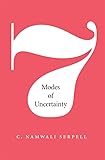Seven Modes of Uncertainty / C. Namwali Serpell.
Material type: TextPublisher: Cambridge, MA : Harvard University Press, [2014]Copyright date: ©2014Description: 1 online resource (403 p.) : 1 tableContent type:
TextPublisher: Cambridge, MA : Harvard University Press, [2014]Copyright date: ©2014Description: 1 online resource (403 p.) : 1 tableContent type: - 9780674729094
- 9780674419674
- 809.39353 23
- online - DeGruyter
- Issued also in print.
| Item type | Current library | Call number | URL | Status | Notes | Barcode | |
|---|---|---|---|---|---|---|---|
 eBook
eBook
|
Biblioteca "Angelicum" Pont. Univ. S.Tommaso d'Aquino Nuvola online | online - DeGruyter (Browse shelf(Opens below)) | Online access | Not for loan (Accesso limitato) | Accesso per gli utenti autorizzati / Access for authorized users | (dgr)9780674419674 |
Frontmatter -- Contents -- Seven Modes Of Uncertainty -- Introduction -- I. Mutual Exclusion -- 1. Oscillation. The Crying Of Lot 49 (1966) -- 2. Enfolding. Rereading Ian McEwan's Atonement (2001) -- II. Multiplicity -- 3. Adjacency Toni Morrison, Beloved (1987) -- 4. Accounting Interreading William Empson'S Seven Types Of Ambiguity (1930), Shirley Jackson'S "Seven Types Of Ambiguity" (1943), And Elliot Perlman'S Seven Types Of Ambiguity (2003) -- III. Repetition -- 5. Vacuity. Bret Easton Ellis, American Psycho (1991) -- 6. Synchronicity Metareading Tom McCarthy's Remainder (2005) -- 7. Conclusion: Flippancy. Jonathan Safran Foer, Extremely Loud & Incredibly Close (2005) -- Appendix 1: The Vagaries Of The New Ethics -- Appendix 2: Seven Modes Of Uncertainty -- Notes -- Acknowledgments -- Index
restricted access online access with authorization star
http://purl.org/coar/access_right/c_16ec
Literature is rife with uncertainty. Literature is good for us. These two ideas about reading literature are often taken for granted. But what is the relationship between literature's capacity to unsettle, perplex, and bewilder us, and literature's ethical value? To revive this question, C. Namwali Serpell proposes a return to William Empson's groundbreaking work, Seven Types of Ambiguity (1930), which contends that literary uncertainty is crucial to ethics because it pushes us beyond the limits of our own experience. Taking as case studies experimental novels by Thomas Pynchon, Toni Morrison, Bret Easton Ellis, Ian McEwan, Elliot Perlman, Tom McCarthy, and Jonathan Safran Foer, Serpell suggests that literary uncertainty emerges from the reader's shifting responses to structures of conflicting information. A number of these novels employ a structure of mutual exclusion, which presents opposed explanations for the same events. Some use a structure of multiplicity, which presents different perspectives regarding events or characters. The structure of repetition in other texts destabilizes the continuity of events and frustrates our ability to follow the story. To explain how these structures produce uncertainty, Serpell borrows from cognitive psychology the concept of affordance, which describes an object's or environment's potential uses. Moving through these narrative structures affords various ongoing modes of uncertainty, which in turn afford ethical experiences both positive and negative. At the crossroads of recent critical turns to literary form, reading practices, and ethics, Seven Modes of Uncertainty offers a new phenomenology of how we read uncertainty now.
Issued also in print.
Mode of access: Internet via World Wide Web.
In English.
Description based on online resource; title from PDF title page (publisher's Web site, viewed 30. Aug 2021)


